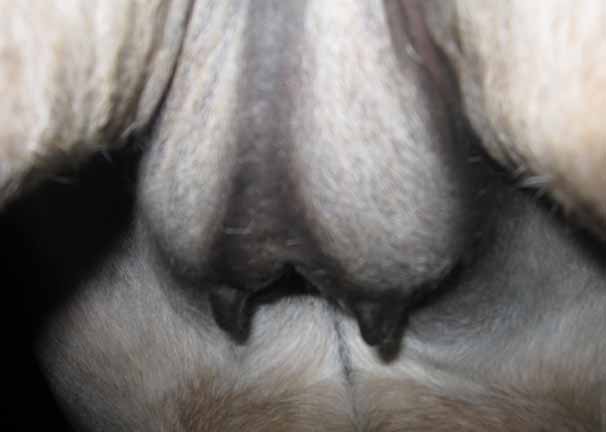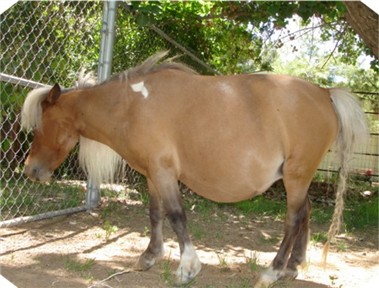Signs of Foaling
I Am Ranch Miniature Horses is
sharing with you what we do to maintain the health of our horses. This
is not intended to direct you on how to care for your horse. The intent of
this is only to share what we do, and raise questions for you. We
advise you to consult your veterinarian before making any changes in
your horse's health care. The information found on our
website is not to supersede the advise of your veterinarian. I AM Ranch
Miniature Horses cannot be held liable for the care of your horse(s).
Are you afflicted with
Pre-Foaling Anxiety Disease?? Come Springtime, our family
catches this disease full force. We call it PFSD!!!
Pre Foaling
Stress
Disorder!! To help me cope, I
started journaling and you can read the journals here on our
site! Look on the articles page to find them.
Those of us with babies coming are obsessing about
when. The foaling season takes over your mind during waking moments and even
during sleep. Here, at our home, we start DREAMING miniature horse babies!
We did have a fun thread on our
AZminiatures yahoo group wherein one breeder told of a mare that
went 384 days and another mare who waited 372 days. Those have got
to be record long for gestation times. On the short end, one
miniature breeder told of a baby born at 296 days with only peach
fuzz, no hair and cartilage for legs. The vet told this lady she
would die, but love and determination (along with lots of hours) has
grown this baby up to be 4 years old now. They had to be there every
2 hours around the clock and support her while she nursed. After 2
weeks, she was getting up on her own! As you can see, there can be a
great amount of variation in how long that foal is in the oven :)
Thus, we start really watching our mares at day 300 of pregnancy. You
can click here for a calculator to help
figure out how far along your mare is.
As you read about each
sign, remember to take each change in concert with the others. Also
remember that "the mares do not read these notes, nor do they listen to
the vets, or read "The Complete Book of Foaling". They have
their babies when they are ready and one mare gives obvious clues while
another surprises you and foals unexpectedly. It is wise to take copious
notes on your mare so that you know her pattern for following years.
Click here to print out a handy data
collection chart for documenting each mare's progress through her
pregnancy.
Your mare's milk will change in
consistency, color and taste as the day of foaling approaches. The milk
will go from clear to cloudy to yellowish to syrupy in texture to opaque
white milk that is sticky and thick. At first, there may be flecks in
the milk, but as the day nears, these dissolve and you see them no more.
These are bits of calcium precipitants! As you see the milk
progressively change, your examinations should be more frequent. The
changes can happen very quickly. If you have a "cup bearer" in your
home, have her taste the milk daily and it will get sweeter. It loses
that salty flavor as the big day of foaling approaches. (If you don't' know what a cup bearer is, get out your Bible, and read Genesis :)
The Complete Book of Foaling
mentions that the milk itself is the most reliable predictor of imminent
foaling.
Udder
Of course we watch the size
and shape of the udder. The mare's teats tend to point toward each other
in the days before foaling is imminent, but as the day draws nearer,
they begin pointing straight down. Typically, a mare starts to bag
up a few weeks pre-foaling, but, there are some mares who don't develop
a bag until the day of foaling. Again, the norm is for the bag to be
fuller in the morning and shrink over the day, until the day of foaling.
Then the bag will stay tight even in the evening. In some mares, you
will see the milk veins filling up in front of her udder.
Watching a mare's bag is not 100% reliable by
itself. We do recommend washing between the teats before the bag fills,
so all of her "cleavage grime" does not irritate her as her bag fills up
and the cleavage area becomes tight. More importantly than udder
shape is the milk consistency.
|
 |
|
See these teats pointing
inwards. She is not ready to foal, even though she looks
very full. |
|
The teats of a mare will
initially point inward, but as her big day approaches, they tend
to point straight downwards. Again, with all of these signs of
foaling, this is not 100% reliable. We have one mare whose teats
point downward for many days before foaling. |
Also, look for wax on the tips of the teats. Miniature mares do not wax up as predictably as big horse mares,
but it is something to look for!
|
.JPG) |
|
Feb 29 |
|
|
 |
|
March 5 |
|
|
|
.JPG) |
|
March 14 |
|
|
.JPG) |
|
March 21 |
|
|
 |
|
Thank you Chris for your "pointy butt"
picture! This mare foaled within a few hours after this
picture. |
|
You need to be watching the
mare's body for many changes. Remember just as our own bodies loosened
up to allow out our babies, so will hers. The ligaments in the pelvic
area relax and you can see a depression in the croup muscles. I picture
the tarp tented over our hay storage. At the top, right below the
highpoint, is a hollow or a sag spot. This is what you will see on your
mare.
Watch a baby kicking inside of momma's belly. |
Minis have a way of clamping
down their tails, but they do get a loose and flexible tail head as
these changes occur.
| Then, the belly! As those
abdominal muscles begin to relax and your mare starts to look like her
belly is touching the ground...you know her time is nearing. We take
silhouetted pictures of our mares to see this change. Take a shot from
the back and from the sides. This change happens the last 2-3 weeks of
pregnancy. Some describe the mare looking more 'V' like from the side
and that she loses the big bulges on either side when viewing
from the front. |
 |
|
There can be both
external and internal changes in the vulva. There is a deepening of color
which happens 24-48 hours pre-foaling and
is related to the increase in circulation. The outer lips of the vulva lose their elasticity and the
slit lengthens. The vulva will almost look like it is sticking
out or hanging much lower.
|
7 PM, the night before foaling
.JPG) |
10 PM, the same night
.JPG) |
Both of these
changes can be unpredictable though due to environmental changes.
Nevertheless, we
always peek just in case we see evidence of the "bloody show."
Most often you will only see a gooey blood on the edges of the vulva. This
occurs when the waxy plug makes its way out. If by chance, you see the
bloody show, you are within 48 hours of foaling. It does not always come
out in one big plug, but can ooze out for the 2 days pre-foaling.
|
We were surprised to read
this predictor for not many talk about temperature changes. Often, we
take the temperatures of our momma dogs to help us figure out their
whelping date, but didn't know until recently that mares also exhibit a
change. You must take their temperature at the same time daily and take
it twice daily. Begin on day 300 of the pregnancy and chart your
readings. Her temperature will drop somewhere between 18-24 hours of
foaling time. This variation will only be .5 - 1.0 degree lower. We are
recording this for the 2008 foaling season and will let you know
the outcome.
We are getting into signs
that are even more subtle, but most mares go off of feed right before
foaling. Their poops look more like a cow was in the stall and can
become more frequent. The mares poop may look more like a cow's poop on
the day that she is going to foal.
Study your mares and know them. This will often be a big
help to you in knowing when their moment has come. They become more
irritated than usual. Our mares bite their sides, kick at their bellies,
walk in circles, get up and lay down frequently, rub their bums on the
barn walls....They may also separate themselves from their herd
when they are ready to foal. They often will stand looking almost
forlorn before foaling. Her behaviors will be different from the
"normal."


